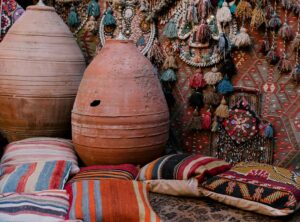The traditional cultures of the black peoples of Africa have their own specificity, which consists in their orientation towards the past. This means that traditional African thinking distinguishes only between the present and the past, which is perceived quite differently than in modern European culture.
The Kenyan scholar J. Mbiti named two dimensions of the specific orientation of Africans to the past with terms taken from the Swahili language: sasa – now and zalgani – long ago. Sasa is a person’s awareness of his or her own existence, the time in which he or she is or has been participating. The older the person, the longer the period of sasa. The future has only a short value, there is no future “in itself”, thinking about the future is a very short projection of sasa on current needs. And if sasa is an autonomous micro-time, then zalgani is a macro-time, everything that has happened before the current moment, the “graveyard of time,” as J. Mbiti put it. However, this spectacular definition should not be understood literally, in the spirit of contemporary European culture, because the “graveyard of time” is alive, it is constantly present in the African present.
This orientation to the past, the constant interpenetration of sasa and zalgani, finds expression in various areas of traditional African cultures: in the field of religious beliefs and rituals, in the field of oral literature, in the field of art, and so on.
The cultures of the African continent have made a significant contribution to the treasury of world culture. First of all, jazz, born on the basis of African traditions, organically entered the context of European culture; its rhythms bring pleasure, so it made a lightning career and was immediately included in the classical repertoire. The emergence of African plastics in Europe was of the greatest importance for the world of artistic plasticity. The echoes of Black African culture can be found in the works of such great artists of the twentieth century as M. Vlaminck, A. Derain, G. Matisse, and, above all, Picasso. The latter managed to combine the two-dimensional perspective adopted in Western painting with the third dimension represented in the forms of African sculpture.
It was this combination that led to Cubism. Artists from the most abstract art groups took up the Cubist forms of African sculpture, and Cubism went down in the history of world culture as one of the most interesting artistic movements. African sculpture also became a source of inspiration for the works of representatives of German Expressionism – E. Nolde, E. Hirchner and others. The ability to synthesize, which characterizes the art of Black Africa, is still one of the directions of artistic search of the world culture. Such poets and writers as Guillaume Appolinier, Jean Cocteau, and others succumbed to the spell of African culture, and artistic circles enthusiastically greeted the collections of myths, poetry, and legends collected on the Black Continent by Leo Frobenius and later published in numerous books and articles. A number of other examples could be cited that demonstrate the life-giving influence of Black African cultures on world culture, but their significance for people of the twentieth century is clear.
La négritude is a concept that has developed over the past 60 years in the context of the worldwide struggle of peoples of color for freedom and unity. It represents the intellectual response of French-educated Antillean and Senegalese blacks to French colonial rule, in particular the policy of assimilation. Martinique’s E. Césaire first used the term “negritude” in 1935. In modern France, a dark-skinned person is called “black,” which used to be “negro,” which had a derogatory connotation, similar to the American “nigger.” E. Césaire deliberately based the term on a word that had negative connotations.
After being picked up and developed by the Senegalese intelligentsia, Negritude, for example, in the 40s and 50s, became a philosophical and historical manifestation of Africans’ aspirations for political and cultural freedom and self-realization. Since the independence of the French-speaking African territories, it has continued to serve as a vehicle for the expression of African aspirations in the modern world.
A leading ideologist of negritude, Césaire’s younger contemporary, L. S. Senghor (for a time the president of Senegal), interpreted negritude as a set of cultural values of Black Africa, and later formulated the concept: negritude is a set of civilizational values-cultural, economic, social, political-that characterize black peoples, or rather the Negro African world.


